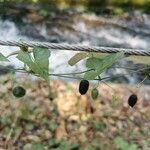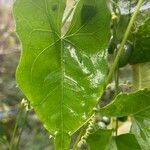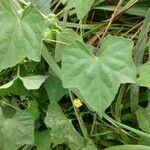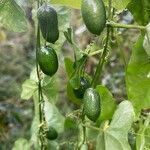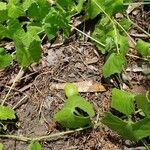Vines; stems scabrous to glabrate. Leaves with blades cordate to sagittate, rarely shallowly 3-to 5-lobate (in other parts of the range sometimes deeply 3-to 5-lobate), 3-7(-10) cm long, to as wide as long, the apex acuminate to caudate, the base cordate, the margin undulate, minutely and remotely toothed, charta-ceous, the upper and the lower surfaces scabrous with white pustular based tri-chomes; petioles 1-4 cm long, scabrous to glabrate; tendrils simple, glabrate. Staminate flowers in axillary, long pedunculate racemes, the rachis 2-3 cm long, filiform, glabrate, 2-to 6-flowered; pedicels 2-3 mm long; calyx campanulate, the lobes subulate, ca. 0.5 mm long, sparsely pilose; corolla yellow, the lobes ovate oblong, acute, spreading, papillose puberulent on the inner surface, puberulent on the outer surface; anthers narrowly oblong, ciliate on the margin; pistillode globose. Pistillate flowers solitary; peduncles 1-3 cm long, glabrate; calyx and corolla as in the staminate flowers; ovary ellipsoidal, glabrous, smooth. Fruits
Stems slender, setulose to glabrous. Petiole slender, retrorsely hispid, 0.9-5 cm; leaf blade adaxially dark green, abaxially paler, ovate to pentagonal, membranous to herbaceous, abaxially shortly hispid or scabrid, adaxially hispid or scabrid-punctate, cordate, unlobed or shallowly to deeply 3-5-lobed, apex obtuse to acuminate, apiculate. Male flowers 3-12 in axillary fascicles, often with an accompanying solitary flower; peduncle slender, 0.5-3.5 cm; pedicels slender, 1.5-9 mm; calyx campanulate, 1.5-3.5 mm, shortly pubescent to glabrous; corolla yellow; segments spreading, obovate-oblong, 1.5-2.5 mm, emarginate, apiculate; stamens 3, two 2-celled, one 1-celled; filaments short, ca. 0.5 mm; anthers ellipsoid. Female flowers solitary, often coaxillary with male flowers; pedicel slender, 0.7-3.5 cm; calyx and corolla as in male flowers. Fruit black when ripe, subglobose to ellipsoid, 0.8-1.9 × 0.8-1.2 cm. Seeds pallid, ovate, compressed, minutely fimbrillate, 4-5 × 2-2.8 mm, 0.6-0.9 mm thick. Fl. and fr. Jan-Dec.
Slender, glabrous vine 1–2 m; lvs orbicular in outline, cordate at base, shallowly or deeply 5-lobed, 3–7 cm; fls few, the pistillate solitary, slender-peduncled, 8 mm wide, the staminate smaller, 2–6 in a short raceme terminating a slender peduncle; fr ovoid, green, 1 cm. Woods; s. Va., s. Ind., and s. Mo. to Fla. and n. Mex. June–Aug.
Leaf blades 5–10 cm, base cordate, surfaces scabrous to hispid. Inflorescences: pistillate flowers on slender peduncles, rarely 2 from single axil. Flowers: hypanthium 1–2 mm; petals: apex emarginate to truncate. Pepos pendulous on peduncles 15–45 mm. Seeds 2–4 mm.
A pumpkin family herb. It is a vine. The leaves are almost heart shaped and have 5 angles or lobes. They are 3-7 cm long by 3-7 cm wide. There are teeth along the edge. The fruit are smooth and black. They are 1 cm long. They have small white seeds.
black, ovoid to elliptical, 0.7-1.5(-2.0) cm long, 0.7-1.0 cm in diameter, smooth, glabrous, baccate; seeds white sericeous, ovoid, 4-5 mnm long, 2-3 mm wide.
